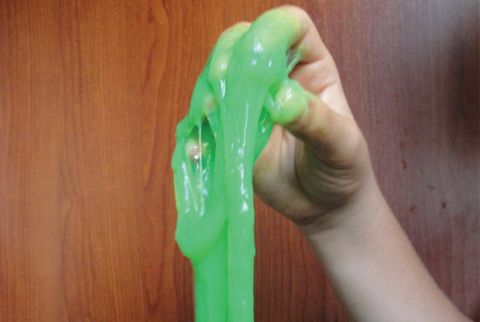Overview
STEM careers
Time
Materials
Per Student:
- Borax
- White glue (like Elmer’s)
- Water
- Food coloring (optional)
- Paper cups
- Ziploc plastic bags
Instructions
In this activity, students explore the different properties of the materials used to make slime and see how they can be combined to form a new material with different properties.
- Add 1 tablespoon of Borax (which you find in the laundry section of the grocery store) to 1 cup of water. Stir until completely dissolved.
- In a separate bowl, mix 1⁄4 cup water with 1⁄4 cup white glue.
- In a Ziploc bag, add 1⁄2 cup of the Borax solution to 1⁄2 cup of the glue solution.
- Add a couple of drops of food coloring.
- Seal the bag and knead the mixture.
- Your slime is ready. Have fun!
- Wash your hands after you play with it and keep it sealed in the bag in the refrigerator. Eventually it will dry out or get moldy.
- Don’t eat it!
Guiding questions
-
What do you think would happen if you didn’t knead the mixture?
-
What practical use could slime have?
-
What objects do you see around you that have been made by combining a number of different materials?
Engineering & science connections
- Materials scientists and engineers work in all industries to study existing materials so they can create new materials with improved characteristics. For example, they research materials to improve roads, create tastier food products, build lighter machines, and design reusable spacecraft.
- All materials have properties that affect how they interact with each other. An interesting feature of slime is that its combined ingredients cause it to absorb a lot of water, which makes the gel. Engineers consider many properties of materials to design usable products, such as strength, water resistance, absorbency, rigidity, and flexibility.
- Sir Isaac Newton stated that fluids should flow at a constant rate. Water, milk, and oil are examples of Newtonian fluids because of their ability to flow freely. Other liquids like honey, ketchup, and liquid glue are considered to be non-Newtonian fluids because of their resistance to flow. Slime is also an example of a non-Newtonian fluid. Engineers are finding many ways of putting non-Newtonian fluids to use, such as filling potholes in roads.


I think it needed more Borax, then it worked, she had so much fun making it, thanks!